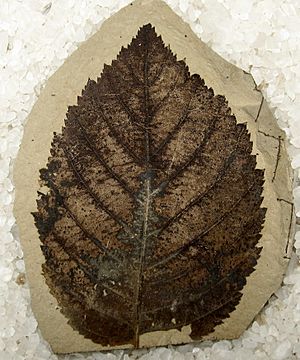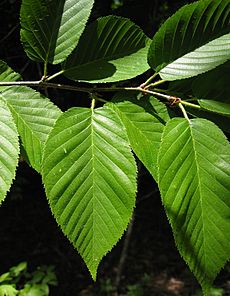Betula leopoldae facts for kids
Quick facts for kids Betula leopoldae |
|
|---|---|
 |
|
| leaf fossil | |
| Scientific classification | |
| Genus: |
Betula
|
| Species: |
leopoldae
|
Betula leopoldae is an extinct type of birch tree. It belongs to the Betulaceae family, which includes birches and alders. We know about this tree from fossils of its leaves, catkins, and flowers. These fossils were found in rocks from the early Eocene epoch. They have been discovered in northern Washington state in the United States and in British Columbia, Canada. Scientists think Betula leopoldae was one of the earliest types of birch trees.
Discovering Betula leopoldae
Fossils of Betula leopoldae have been found in several places in Western North America. One important site is the Klondike Mountain Formation near Republic, Washington. The fossils there are about 49 million years old. Other sites include the Allenby Formation near Princeton, the Falkland fossil site near Falkland, and the McAbee Fossil Beds. These Canadian sites are part of the Kamloops Group's Tranquille Formation. Fossils were also found at the Quilchena fossil site near Quilchena, British Columbia.
Most of these fossil sites are from the Early Eocene time period. Some sites have been dated using special methods like uranium-lead or argon–argon. These dates show the fossils are from the Ypresian age. Other sites might be a bit younger.
Scientists first described Betula leopoldae from fossils found in Republic, Washington, in the early 1980s. The main leaf fossil, called the holotype, is kept at the Burke Museum. Another important leaf fossil, called the paratype, is also there. A matching part of the holotype fossil is at the University of California Museum of Paleontology.
Two scientists, Jack A. Wolfe and Wesley C. Wehr, studied these fossils. They published their findings in 1987. They named the species leopoldae to honor Estella Leopold. She was a famous scientist who studied ancient plants and worked to protect nature.
Later that same year, other scientists, Peter Crane and Ruth Stockey, found more B. leopoldae fossils. They found leaves, catkins (which are like flower clusters), and pollen in the Allenby Formation. This discovery was very important. It was the oldest complete record of a Betula species, showing both its leaves and its reproductive parts. One leaf fossil even showed clear signs of insect feeding damage. It looked like an insect had eaten four sections of the leaf.
How it's Related to Other Birches

When Wolfe and Wehr first described Betula leopoldae, they didn't place it into a specific group of birches. But the fossils from the Allenby Formation were more complete. This allowed scientists Crane and Stockey to study its relationships more closely.
They noticed that B. leopoldae was similar to a living birch species called Betula alleghaniensis. This living tree is also known as the yellow birch. Scientists now use DNA comparisons to understand how different plants are related. These studies show that B. leopoldae is a very early type of birch. It might be an ancestor to many modern birch trees.
What Betula leopoldae Looked Like
The leaves of B. leopoldae were shaped like an oval or circle. They could be up to 145 mm (5.7 in) long, but usually they were between 60–90 mm (2.4–3.5 in) long. Their width was typically 30–50 mm (1.2–2.0 in). The leaf stems, called petioles, were 7–18 mm (0.28–0.71 in) long.
The edges of the leaves were serrated, meaning they had a saw-toothed pattern. There were larger main teeth, with up to seven smaller teeth in between them. Each main tooth had a vein running to it. The leaves had veins arranged like a feather, called pinnately veined. A main vein ran down the middle, and smaller veins branched off it. These smaller veins curved upwards near the leaf tips. The underside of the leaves, the edges, and the petioles had many tiny hairs. On smaller leaves, these hairs were very thick.
The B. leopoldae also had fruiting heads. These grew on stalks called peduncles. Each stalk had many small, three-lobed leaf-like parts called bracts. Each bract was paired with a fruiting head. The fruiting heads were 20–35 mm (0.79–1.38 in) long and 9–12 mm (0.35–0.47 in) wide. The fruits inside were 2.0–3.5 mm (0.079–0.138 in) long and had an oval shape. They had a thin edge and two simple parts at the tip, called styles.
The B. leopoldae flowering heads were 40–45 mm (1.6–1.8 in) long and 7–10 mm (0.28–0.39 in) wide. They contained 30 to 40 individual flowers. These flowers had triangular bracts and parts called stamens. The stamens held pollen grains. These pollen grains had three round pores and a rough outer surface.

